
As they always say: a church organ never dies, and on that note…
Well, perhaps they don’t say that very often, but it can be very difficult to scrap a church organ. This week at Partick Methodist Church, the organ installed in 1886, is being carefully, painstakingly, removed. It will be going to Gorey in County Wexford, where it will be lovingly reinstalled – the organ renewed, in some ways – in a Catholic Church. The Methodist Church, seen below, contained the valuable Forster and Andrews organ; however, originally the pipes were painted a very different colour, more like gold. It is only belatedly that they were ‘toned’ down.

Memorial Service
On 2 October 2022 we had a Memorial service for the Organ, where our own organist could give it laldy (Scottish term for ‘give it everything’). Margaret has been playing this organ for 30 years.
Our Youtube recording of that service is here, in two versions: the concise two minute or ‘full’ 45 minute.
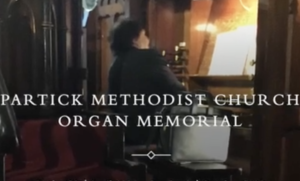
Installation
We have the original documents and advertisements for the ‘opening’ of the organ at the Church back on 2nd April 1886.
Peculiarities

The invoice for the organ, above, highlights the perception of cost these days
Note how much the organ originally cost…more of which below.
Eulogy
David Gibson gave a stirring ‘eulogy’ or tribute to the life of the organ that day. I have added this here:
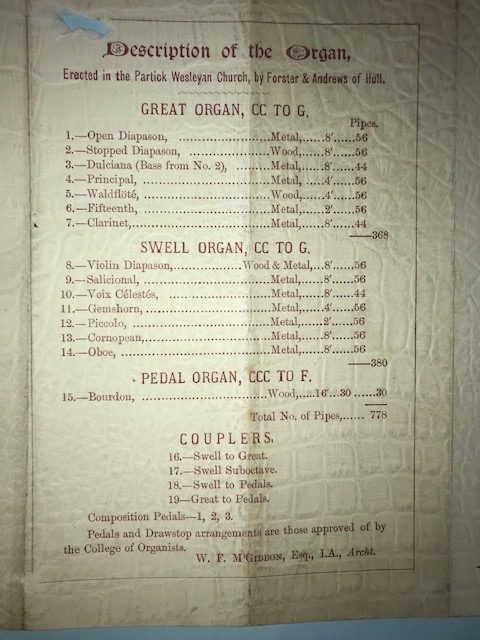
There’s been a society of Methodists in Partick for something over 150 years. Initially meeting in halls from 1868, the site here on Dumbarton Road was acquired 12 years later in 1880 and the Church was built and opened in 1881. The original trustees (there were 17 out of a membership of 48) included Henry Alexander and his son Henry J.E. Alexander. And the significance of these names is that four years later in 1885 (membership 130), Henry Alexander donated the funds for the purchase of the organ in memory of his son Henry J.E. Alexander.
The organ was built by Forster and Andrews, of Hull, who were probably the pre-eminent organ builders at the time. The price? £300. To put that into context, you could buy a house for £300 in 1885. We have a copy of the order from the records of Forster and Andrews, detailing the technical specifications and timbres of the organ. And the order also lists the extras paid in addition (bit like buying a car nowadays). Which include, Margaret you will be DELIGHTED to hear, a seat for the organist – cost £1, 15 shillings (or £1.75 in today’s currency). No expense spared for the comfort of the organist, eh Margaret!

The organ was dedicated with an Opening Recital on Friday 2nd April 1886. We have the programme. “Organ Recital with Vocal Selections by the Church Choir assisted by Eminent Soloists”. What I like is that at the bottom it says “Doors open 7.30pm; Recital at 8 precisely” – how very Methodist!
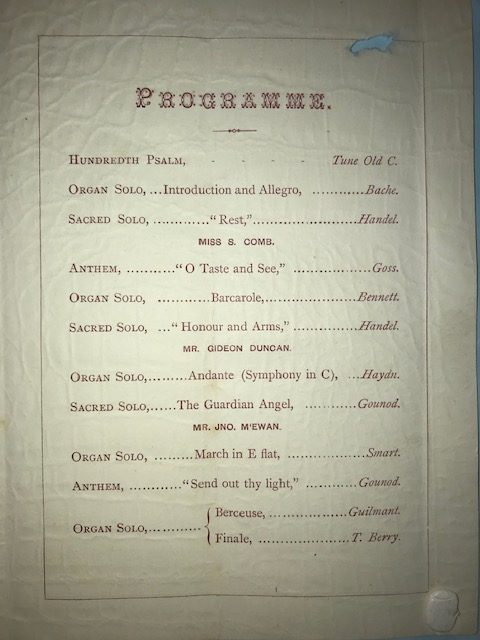
And so, the organ became part of the life of the Church, part of the fabric of our folk. It framed our worship, our rites of passage, of baptism, marriage and passing, of happy times and not so happy times. They say that Methodism was born in song and Methodists sing and our folk have sung to this organ for 136 years.
During that time, the organ has worked its way through a large number of organists. Our records show that from 1950 onwards there were some 23 organists. The current incumbent being our esteemed Mrs Margaret Steele who has notched up 29 years. [And plenty of years left for our new instrument in our new premises, Margaret.]
For over 30 years (probably nearer 40) there were regular organ recitals on a Saturday afternoon open to the public given by the late Gordon Frier. These continued right up until the closure of the Church due to the Covid Pandemic and were a feature of the musical life in the west of the city. It was a form of musical outreach where people could come and sit out of the hussle and bussle of the world outside.
As you know, there are plans for the redevelopment of the Church and we are not able to keep or house the organ in our hoped-for new premises. One of our principal priorities has been to save and preserve the instrument. And it is listed by the Glasgow Society of Organists as one of the finest organs in Scotland. But more, so that it can continue its mission of worship. We are delighted that we have found a home for the organ in St Michael’s Church, Gorey, County Wexford in Ireland.
St. Michael’s Church, Gorey, was built by Pugin (one of the architects of the Houses of Parliament) in 1839 in the 12thCentury Norman or Romanesque style (if some of you are surprised at this erudition, it comes out of a book) – apparently, it is one of only three churches built by Pugin in this style, all his other churches being in the Gothic style. So, the church is not overly ornate – it’s been described as “large and sober”, so a Methodist organ will be very much at home there!
In November, specialist organ builders will come and dismantle the organ and remove it to their workshop in County Wexford, where it will be restored and then re-built and take its place in St Michael’s. It will take a year. [* the date for the dismantling was delayed, meaning we could hear it at Christmas]
And then the organ, or as we are calling it “The Partick Organ”, which was dedicated to the glory of God and to the service of the Lord will be fit for service and to continue its mission for another 136 years.
And it goes with our grateful thanks and with all our love.

Organists
We have had an array of organists at Partick. It’s fitting to acknowledge them as well as the service of the church organ.
Dismantling
As the Church Organ renovators started their work, a glimpse was taken at the dismantled church organ, laid bare across the whole breadth of the church pews.

Here we can see the communion table in the middle with the central pulpit and stairs behind that. Beyond the pulpit we have exposed wall where the organ was installed. Note the intricate wall covering in the in-vogue Etruscan Red colour of the time (below) and the architrave, which is missing in certain positions.
To the left – by the door – is a series of wooden boxes, each one containing parts of the dismantled pipes and connections. In the foreground lies the array of organ pipes, filling the central pews – as they may well have done back when first installed. These will be taken back to Ireland for a period of restoration, an organ renewal process.
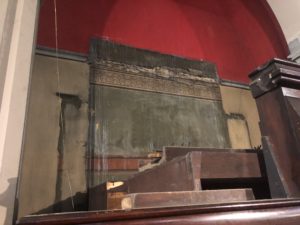
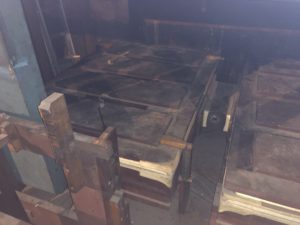
The image of the bellows (seen right), beneath where the pipes were fitted, offer an insight into the technology available back then. They had the capability to be driven by hand or by electricity when that became available in Partick. The dismantling of the organ also revealed an inscription:
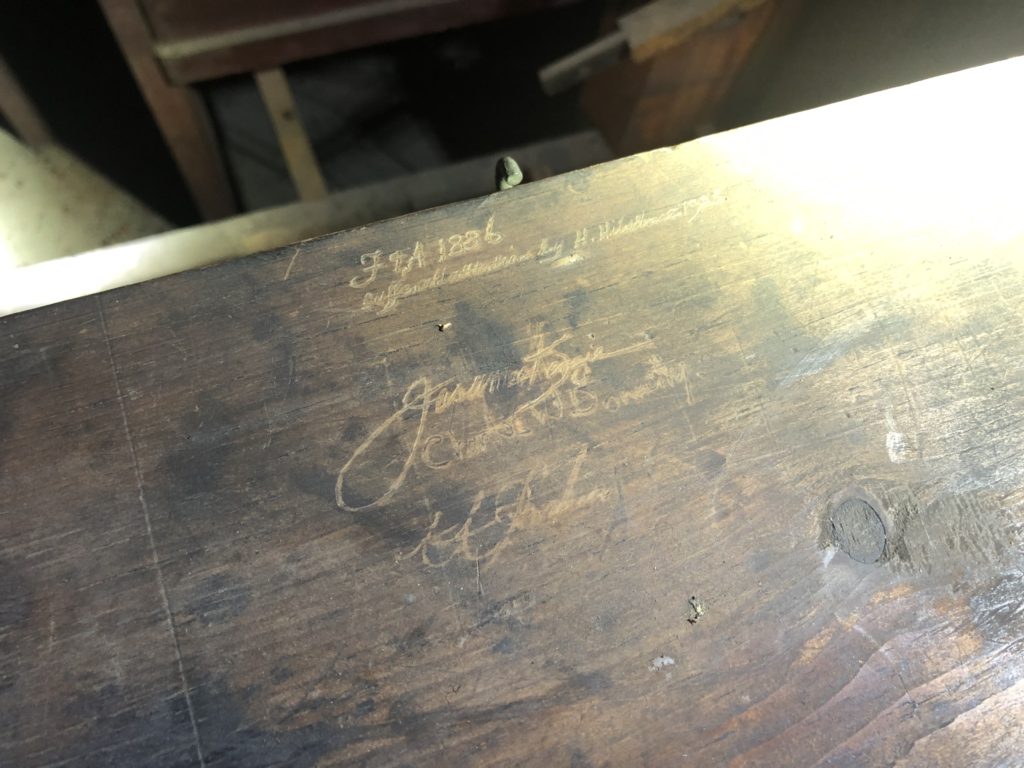
It also revealed a more modern ‘inscription’ – a business card from 1975. When we rang the modified number – as the Glasgow dealing code had changed since then – the lady was most surprised to find that her late husbands’ work was still going strong. She was so pleased to hear that the church organ would be playing for many years to come in Ireland.
The future?
This leaves us a little sad. So what of the future? The organ, once restored, will go to its new home in County Wexford. The sanctuary will be rebuilt, offering fresh opportunities for the local and our community to remain as one. The new church will be a focal point, and will be both ecologically designed and far cheaper to run. We may see new initiatives springing forth from Partick. It is not the end, but a new beginning.
I am enjoying the dialogue